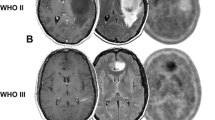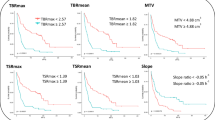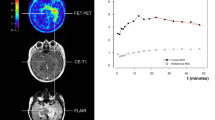Abstract
The prognostic value of PET with (18F)-fluoro-2-deoxy-d-glucose (FDG) has been shown in high-grade gliomas (HGG), but not compared with consensual prognostic factors. We sought to evaluate the independent predictive value of pre-treatment FDG-PET on overall (OS) and event-free survival (EFS). We retrospectively analyzed 41 patients with histologically-confirmed HGG (31 glioblastomas and 10 anaplastic gliomas). The pre-treatment uptake of FDG was assessed qualitatively by five-step visual metabolic grading, and quantitatively by the ratio between the tumor and contralateral maximal standardized uptake value (T/CL). EFS and OS following PET were compared with FDG uptake by univariate analysis, and by two multivariate analyses: one including main consensual prognostic factors (age, KPS, extent of surgery and histological grade), and the other including the classification system of the Radiation Therapy Oncology Group (Recursive Partitioning Analysis, RPA). Median OS and EFS were 13.8 and 7.4 months, respectively, for glioblastomas, and over 25.8 and 12 months, respectively, for anaplastic gliomas (P = 0.040 and P = 0.027). The T/CL ratio predicted OS in the entire group [P = 0.003; Hazard Ratio (HR) = 2.3] and in the glioblastoma subgroup (P = 0.018; HR = 2), independently of age, Karnofsky performance status, histological grade, and surgery, and independently of RPA classification. T/CL ratio tended to predict EFS in the whole group (P = 0.052). The prognostic value of visual metabolic grade on OS was less significant than T/CL ratio, both in the entire group and in the glioblastoma subgroup (P = 0.077 and P = 0.059). Quantitative evaluation of the ratio between the maximal tumor and contralateral uptake in pre-treatment FDG-PET provides significant additional prognostic information in newly-diagnosed HGG, independently of consensual prognostic factors.


Similar content being viewed by others
References
Kleihues P, Cavenee WK (2000) World Health Organization Classification of Tumours.Pathology and genetics of tumours of the nervous system. IARC Press, Lyon
Louis DN, Ohgaki H, Wiestler OD et al (2007) The 2007 WHO classification of tumours of the central nervous system. Acta Neuropathol 114:97–109
Behin A, Hoang-Xuan K, Carpentier AF, Delattre JY (2003) Primary brain tumours in adults. Lancet 361:323–331
Lacroix M, Abi-Said D, Fourney DR et al (2001) A multivariate analysis of 416 patients with glioblastoma multiforme: prognosis, extent of resection, and survival. J Neurosurg 95:190–198
Curran WJ Jr, Scott CB, Horton J et al (1993) Recursive partitioning analysis of prognostic factors in three Radiation Therapy Oncology Group malignant glioma trials. J Natl Cancer Inst 85:704–710
Gupta T, Sarin R (2002) Poor-prognosis high-grade gliomas: evolving an evidence-based standard of care. Lancet Oncol 3:557–564
Gorlia T, van den Bent MJ, Hegi ME et al (2008) Nomograms for predicting survival of patients with newly diagnosed glioblastoma: prognostic factor analysis of EORTC and NCIC trial 26981–22981/CE.3. Lancet Oncol 9:29–38
Mittler MA, Walters BC, Stopa EG (1996) Observer reliability in histological grading of astrocytoma stereotactic biopsies. J Neurosurg 85:1091–1094
Coons SW, Johnson PC, Scheithauer BW, Yates AJ, Pearl DK (1997) Improving diagnostic accuracy and interobserver concordance in the classification and grading of primary gliomas. Cancer 79:1381–1393
Morita M, Rosenblum MK, Bilsky MH, Fraser RA, Rosenfeld MR (1996) Long-term survivors of glioblastoma multiforme: clinical and molecular characteristics. J Neurooncol 27:259–266
Scott JN, Rewcastle NB, Brasher PM et al (1999) Which glioblastoma multiforme patient will become a long-term survivor? A population-based study. Ann Neurol 46:183–188
Warburg O (1956) On the origin of cancer cells. Science 123:309–314
Bourguet P, Blanc-Vincent MP, Boneu A et al (2003) Summary of the standards, options and recommendations for use of positron emission tomography with 2[18F]fluoro-2-deoxy-d-glucose (FDP-PET scanning) in oncology (2002). Br J Cancer 89:S84–S91
Vander Borght T, Asenbaum S, Bartenstein P et al (2006) EANM procedure guidelines for brain tumour imaging using labelled amino acid analogues. Eur J Nucl Med Mol Imaging 33:1374–1380
Di Chiro G, DeLaPaz RL, Brooks RA et al (1982) Glucose utilization of cerebral gliomas measured by (18F) fluorodeoxyglucose and positron emission tomography. Neurology 32:1323–1329
De Witte O, Lefranc F, Levivier M, Salmon I, Brotchi J, Goldman S (2000) FDG-PET as a prognostic factor in high-grade astrocytoma. J Neurooncol 49:157–163
Alavi JB, Alavi A, Chawluk J et al (1988) Positron emission tomography in patients with glioma. A predictor of prognosis. Cancer 62:1074–1078
Mineura K, Sasajima T, Kowada M et al (1994) Perfusion and metabolism in predicting the survival of patients with cerebral gliomas. Cancer 73:2386–2394
Barker FG II, Chang SM, Valk PE, Pounds TR, Prados MD (1997) 18-Fluorodeoxyglucose uptake and survival of patients with suspected recurrent malignant glioma. Cancer 79:115–126
Kim CK, Alavi JB, Alavi A, Reivich M (1991) New grading system of cerebral gliomas using positron emission tomography with F-18 fluorodeoxyglucose. J Neurooncol 10:85–91
Patronas NJ, Di Chiro G, Kufta C et al (1985) Prediction of survival in glioma patients by means of positron emission tomography. J Neurosurg 62:816–822
Padma MV, Said S, Jacobs M et al (2003) Prediction of pathology and survival by FDG PET in gliomas. J Neurooncol 64:227–237
Kaschten B, Stevenaert A, Sadzot B et al (1998) Preoperative evaluation of 54 gliomas by PET with fluorine-18-fluorodeoxyglucose and/or carbon-11-methionine. J Nucl Med 39:778–785
Colavolpe C, Guedj E, Metellus P et al (2008) FDG-PET to predict different patterns of progression in multicentric glioblastoma: a case report. J Neurooncol 90:47–51
Spence AM, Muzi M, Graham MM et al (2002) 2-(18F)Fluoro-2-deoxyglucose and glucose uptake in malignant gliomas before and after radiotherapy: correlation with outcome. Clin Cancer Res 8:971–979
Macdonald DR, Cascino TL, Schold SC Jr, Cairncross JG (1990) Response criteria for phase II studies of supratentorial malignant glioma. J Clin Oncol 8:1277–1280
Hamacher K, Coenen HH, Stöcklin G (1986) Efficient stereospecific synthesis of no-carrier-added 2-(18F)-fluoro-2-deoxy-d-glucose using aminopolyether supported nucleophilic substitution. J Nucl Med 27:235–238
Schifter T, Hoffman JM, Hanson MW et al (1993) Serial FDG-PET studies in the prediction of survival in patients with primary brain tumors. J Comput Assist Tomogr 17:509–561
Stupp R, Mason WP, van den Bent MJ et al (2005) Radiotherapy plus concomitant and adjuvant temozolomide for glioblastoma. N Engl J Med 352:987–996
Pardo FS, Aronen HJ, Fitzek M et al (2004) Correlation of FDG-PET interpretation with survival in a cohort of glioma patients. Anticancer Res 24:2359–2365
Borbély K, Nyáry I, Tóth M, Ericson K, Gulyás B (2006) Optimization of semi-quantification in metabolic PET studies with 18F-fluorodeoxyglucose and 11C-methionine in the determination of malignancy of gliomas. J Neurol Sci 246:85–94
Giammarile F, Cinotti LE, Jouvet A et al (2004) High and low grade oligodendrogliomas (ODG): correlation of amino-acid and glucose uptakes using PET and histological classifications. J Neurooncol 68:263–274
Meyer PT, Schreckenberger M, Spetzger U et al (2001) Comparison of visual and ROI-based brain tumour grading using 18F-FDG PET: ROC analyses. Eur J Nucl Med 28:165–174
Hustinx R, Smith RJ, Benard F, Bhatnagar A, Alavi A (1999) Can the standardized uptake value characterize primary brain tumors on FDG-PET? Eur J Nucl Med 26:1501–1509
Kim S, Chung JK, Im SH et al (2005) 11C-methionine PET as a prognostic marker in patients with glioma: comparison with 18F-FDG PET. Eur J Nucl Med Mol Imaging 32:52–59
Pötzi C, Becherer A, Marosi C et al (2007) (11C) methionine and (18F) fluorodeoxyglucose PET in the follow-up of glioblastoma multiforme. J Neurooncol 84:305–314
Herholz K, Wienhard K, Heiss WD (1990) Validity of PET studies in brain tumors. Cerebrovasc Brain Metab Rev 2:240–265
Goldman S, Levivier M, Pirotte B et al (1996) Regional glucose metabolism and histopathology of gliomas. A study based on positron emission tomography-guided stereotactic biopsy. Cancer 78:1098–1106
Macbeth RAL, Bekesi JG (1962) Oxygen consumption and anaerobic glycolysis of human malignant and normal tissue. Cancer Res 22:244–248
Yamamoto T, Seino Y, Fukumoto H et al (1990) Over-expression of facilitative glucose transporter genes in human cancer. Biochem Biophys Res Commun 170:223–230
Graham JF, Cummins CJ, Smith BH, Kornblith PL (1985) Regulation of hexokinase in cultured gliomas. Neurosurgery 17:537–542
Galanaud D, Chinot O, Metellus P, Cozzone P (2005) Magnetic resonance spectroscopy in gliomas. Bull Cancer 92:327–331
Hamstra DA, Chenevert TL, Moffat BA et al (2005) Evaluation of the functional diffusion map as an early biomarker of time-to-progression and overall survival in high-grade glioma. Proc Natl Acad Sci USA 102:16759–16764
De Witte O, Goldberg I, Wikler D et al (2001) Positron emission tomography with injection of methionine as a prognostic factor in glioma. J Neurosurg 95:746–750
Nojiri T, Nariai T, Aoyagi M et al (2009) Contributions of biological tumor parameters to the incorporation rate of L[methyl-(11)C] methionine into astrocytomas and oligodendrogliomas. J Neurooncol 93:233–241
Floeth FW, Pauleit D, Sabel M et al (2007) Prognostic value of O-(2–18F-fluoroethyl)-l-tyrosine PET and MRI in low-grade glioma. J Nucl Med 48:519–527
Torii K, Tsuyuguchi N, Kawabe J et al (2005) Correlation of amino-acid uptake using methionine PET and histological classifications in various gliomas. Ann Nucl Med 19:677–683
Ribom D, Eriksson A, Hartman M et al (2001) Positron emission tomography (11)C-methionine and survival in patients with low-grade gliomas. Cancer 92:1541–1549
Pöpperl G, Kreth FW, Mehrkens JH et al (2007) FET PET for the evaluation of untreated gliomas: correlation of FET uptake and uptake kinetics with tumour grading. Eur J Nucl Med Mol Imaging 34:1933–1942
Talbot JN, Kerrou K, Montravers F, Nataf V, Chevalme Y (2007) FDOPA PET has clinical utility in brain tumour imaging: a proposal for a revision of the recent EANM guidelines. Eur J Nucl Med Mol Imaging 34:1131–1132
Heiss WD, Wienhard K, Wagner R et al (1996) F-dopa as an amino acid tracer to detect brain tumors. J Nucl Med 37:1180–1182
Chen W, Cloughesy T, Kamdar N et al (2005) Imaging proliferation in brain tumors with 18F-FLT PET: comparison with 18F-FDG. J Nucl Med 46:945–952
Chen W, Silverman DH, Delaloye S et al (2006) 18F-FDOPA PET imaging of brain tumors: comparison study with 18F-FDG PET and evaluation of diagnostic accuracy. J Nucl Med 47:904–911
Cher LM, Murone C, Lawrentschuk N et al (2006) Correlation of hypoxic cell fraction and angiogenesis with glucose metabolic rate in gliomas using 18F-fluoromisonidazole, 18F-FDG PET, and immunohistochemical studies. J Nucl Med 47:410–418
Schnell O, Krebs B, Carlsen J et al (2009) Imaging of integrin alpha(v)beta(3) expression in patients with malignant glioma by [18F] Galacto-RGD positron emission tomography. Neuro Oncol 11:861–870
Spence AM, Muzi M, Mankoff DA et al (2004) 18F-FDG PET of gliomas at delayed intervals: improved distinction between tumor and normal gray matter. J Nucl Med 45:1653–1659
Di Chiro G (1987) Positron emission tomography using (18F) fluorodeoxyglucose in brain tumors. A powerful diagnostic and prognostic tool. Invest Radiol 22:360–371
Conflict of interest
The authors declare that they have no conflict of interest.
Author information
Authors and Affiliations
Corresponding author
Rights and permissions
About this article
Cite this article
Colavolpe, C., Metellus, P., Mancini, J. et al. Independent prognostic value of pre-treatment 18-FDG-PET in high-grade gliomas. J Neurooncol 107, 527–535 (2012). https://doi.org/10.1007/s11060-011-0771-6
Received:
Accepted:
Published:
Issue Date:
DOI: https://doi.org/10.1007/s11060-011-0771-6




